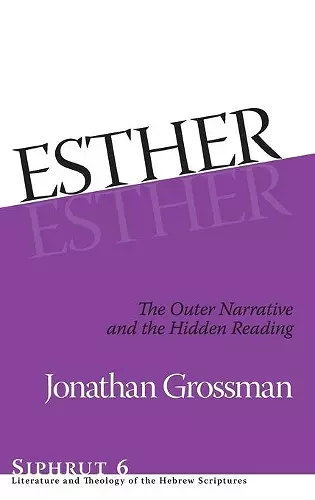Esther
The Outer Narrative and the Hidden Reading
Format:Hardback
Publisher:Pennsylvania State University Press
Published:30th Jun '11
Currently unavailable, and unfortunately no date known when it will be back

Using narrative devices such as allusions and free associations, multivalent expressions, and irony, the author of Esther wrote a story that is about a Jewish woman, Esther, during the time of the Persian exile of Yehudites, and the Persian king, Ahasuerus, who was in power at the time. At various junctures, the author also used secret writing, or we could say that he conveys mixed messages: one is a surface message, but another, often conflicting message lies beneath the surface. For instance, the outer portrayal of the king as one of the main protagonists is an ironic strategy used by the author to highlight the king’s impotent, indecisive, “antihero” status. He may wield authority—as symbolized by his twice-delegated signet ring—but he remains powerless. Among all the concealments in the story, the concealment of God stands out as the most prominent and influential example.
A growing number of scholars regard the book of Esther as a “comic diversion,” the function and intention of which are to entertain the reader. However, Grossman is more convinced by Mikhail Bakhtin’s approach, and he labels his application of this approach to the reading of Esther as “theological carnivalesque.” Bakhtin viewed the carnival (or the carnivalesque genre) as a challenge by the masses to the governing establishment and to accepted social conventions. He described the carnival as an eruption of ever-present but suppressed popular sentiments. The connection between the story of Esther and Bakhtin’s characterization of the carnivalesque in narrative is evident especially in the book of Esther’s use of the motifs of “reversal” and “transformation.” For example, the young girl Esther is transformed from an exiled Jewess into a queen in one of the turnabouts that characterize the narrative. Many more examples are provided in this analysis of one of the Bible’s most fascinating books.
“[Grossman] coins the phrase ‘theological carnivalesque’ to describe the Esther narrative, asserting that the story is meant to emphasize the instability of life in general in which no human being, however powerful, truly knows what is going on. [Grossman]’s study reads easily and is full of intriguing and suggestive observations about the text of Esther, particularly in noting echoes of other biblical writings.”
—Deborah W. Rooke Journal for the Study of the Old Testament
ISBN: 9781575062211
Dimensions: 229mm x 152mm x 25mm
Weight: 635g
264 pages